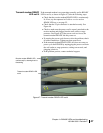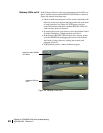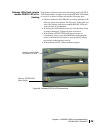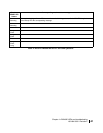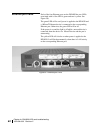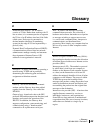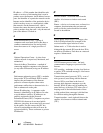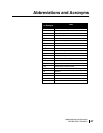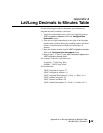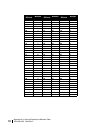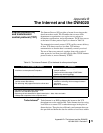
• Glossary
64
1031484-0001 Revision 2
IP address - a 32-bit number that identifies each
sender or receiver of information that is sent in
packets across the Internet. An IP address has two
parts: the identifier of a particular network on the
Internet and an identifier of the particular device
(which can be a server or a workstation) within
that network. On the Internet itself - that is,
between the router that move packets from one
point to another along the route - only the network
part of the address is looked at.
L
N
P
R
S
T
Local area network (LAN) - a group of
computers and associated devices that share a
common communications line and typically
share the resources of a single processor or
server.
National Operations Center - A place from
which a network is supervised, monitored, and
maintained.
Network Address Translation - a method of
connecting multiple computers to the Internet
(or any other IP network) using one IP address.
Performance enhancing proxy (PEP) - modules
that provide TCP acceleration. PEP is used to
improve the performance of the Internet
protocols on network paths where native
performance suffers due to characteristics of a
link or subnetwork on the path.
Private IP addressing - A computer on the
Internet is identified by its IP address. In order
to avoid address conflicts, IP addresses are
publicly registered with the Network
Information Centre (NIC). Computers on private
TCP/IP LANs however do not need public
addresses, since they do not need to be accessed
by the public. For this reason, the NIC has
reserved certain addresses that will never be
registered publicly. These are known as private
IP addresses.
Receive modem - downloads data from the
satellite. Also known as indoor receive unit
(IRU).
Router - a device or, in some cases, software in a
computer, that determines the next network
point to which a packet should be forwarded
toward its destination.
Signal quality factor (SQF) - an integer value
from 0-99 that indicates the strength of the
received satellite signal relative to noise.
Subnet mask - a 32-bit value that is used to
distinguish the network ID from the host ID in
an arbitrary IP address. Each host on a network
requires a subnet mask.
TCP/IP internet protocol suite - the basic
communication language or protocol of the
Internet.
TCP spoofing - technique of using local devices
to answer TCP overhead messages. Also known
as Turbo Internet.
Transmission control protocol (TCP) - a set of
rules (protocol) used along with the Internet
Protocol (IP) to send data in the form of
message units between computers over the
Internet. While IP takes care of handling the
actual delivery of the data, TCP takes care of
keeping track of the individual units of data
(called packets) that a message is divided into
for efficient routing through the Internet.
Transmit modem - sends (uploads) data to the
satellite. Also known as indoor transmit unit
(ITU).




